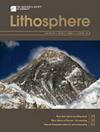西阿尔泰造山带中生代热构造演化:来自低温热年代学的启示
IF 1.7
4区 地球科学
Q3 GEOCHEMISTRY & GEOPHYSICS
引用次数: 0
摘要
中亚造山带的中新生代构造活动对现今中亚地形的形成起着重要的控制作用。阿尔泰造山带是南华夏带的关键组成部分;迄今为止,对其中生代以来构造活化的时间和机制仍缺乏足够的约束。本文给出了阿尔泰西造山带哈巴河地区花岗岩样中锆石、磷灰石(U-Th)/He和磷灰石裂变径迹热年代学资料。其中锆石(U-Th)/He年龄为~230 ~ ~238 Ma,磷灰石裂变径迹中心年龄为~140 ~ 157 Ma,磷灰石(U-Th)/He年龄为~134 ~ ~149 Ma。热史模拟结果表明,哈巴河地区在晚三叠世至中侏罗统(~230 ~ 170 Ma)经历了中等冷却阶段,冷却速率为~0.8 ~ 1.1℃/Ma;在中侏罗统至早白垩统(170 ~ 130 Ma)经历了中等至略快速冷却阶段,冷却速率为~1.5 ~ 2.3℃/Ma。我们认为,这一漫长的冷却阶段发生在阿尔泰西部贯穿早中生代的长期收缩构造作用下,该构造作用是东亚多板块辐合作用的产物,主要包括东北的蒙古-鄂霍次克洋和南部的中特提斯洋的消耗。该地区晚白垩世-新生代的降温和掘出作用有限,原因是再活化作用不足,地表侵蚀作用弱。本文章由计算机程序翻译,如有差异,请以英文原文为准。
Mesozoic Thermo-Tectonic Evolution of the Western Altai Orogenic Belt (NW China): Insights from Low-Temperature Thermochronology
The Meso-Cenozoic tectonic activities of the Central Asian Orogenic Belt (CAOB) played an important role in controlling the present-day topography of Central Asia. The Altai orogenic belt is a key component in the southern CAOB; so far, there is still a lack of sufficient constraints on the time and mechanism of its tectonic reactivation since the Mesozoic. In this contribution, we present new zircon and apatite (U-Th)/He and apatite fission track thermochronological data from granitoid samples in the Habahe area, western Altai orogenic belt. Therein zircon (U-Th)/He ages range from ~230 to ~238 Ma, apatite fission track central ages are ~140–157 Ma, and apatite (U-Th)/He ages vary from ~134 to ~149 Ma. Based on the associated thermal history modeling results, the Habahe area underwent a moderate cooling during the Late Triassic to Middle Jurassic (~230–170 Ma) with a cooling rate of ~0.8–1.1℃/Ma and a subsequent moderate to slightly rapid cooling stage during the Middle Jurassic to Early Cretaceous (170–130 Ma) with a cooling rate of ~1.5–2.3℃/Ma. We propose that this prolonged cooling stage occurred under a long-lasting contractional tectonism in the western Altai throughout the early Mesozoic, which was produced by multiplate convergence in East Asia during this period, mainly including the consumption of the Mongol-Okhotsk Ocean in the northeast and the Meso-Tethys Ocean in the south. The region experienced rather limited Late Cretaceous-Cenozoic cooling and exhumation due to insufficient reactivation and weak surficial erosion.
求助全文
通过发布文献求助,成功后即可免费获取论文全文。
去求助
来源期刊

Lithosphere
GEOCHEMISTRY & GEOPHYSICS-GEOLOGY
CiteScore
3.80
自引率
16.70%
发文量
284
审稿时长
>12 weeks
期刊介绍:
The open access journal will have an expanded scope covering research in all areas of earth, planetary, and environmental sciences, providing a unique publishing choice for authors in the geoscience community.
 求助内容:
求助内容: 应助结果提醒方式:
应助结果提醒方式:


